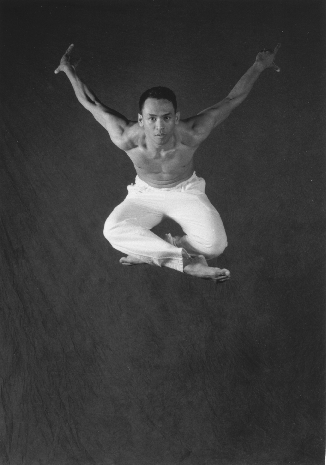Light in the Attic
Program
One
Summerfest/Dance presents
West Wave Dance Festival 2004
Cowell
Theater
San Francisco, California
July
21, 2004
By
Christopher Correa
copyright
© 2004 by Christopher Correa
published July 26, 2004
 The
ODC Theater resembles a loft of exposed wood framework walls and a roof
so thin that streams of violet filter through at dusk. It’s a welcoming
space for choreographers, budding and established, to present new works
in contemporary dance. Informal and homey, Summerfest’s West Wave
Dance Festival has imported a bouquet of dance ensembles to perform, 12
of whom did so in this attic-like setting for Programs One and Two. (Programs
Three and Four run through August 1st at the Cowell Theater at Fort Mason
Center).
The
ODC Theater resembles a loft of exposed wood framework walls and a roof
so thin that streams of violet filter through at dusk. It’s a welcoming
space for choreographers, budding and established, to present new works
in contemporary dance. Informal and homey, Summerfest’s West Wave
Dance Festival has imported a bouquet of dance ensembles to perform, 12
of whom did so in this attic-like setting for Programs One and Two. (Programs
Three and Four run through August 1st at the Cowell Theater at Fort Mason
Center).
A premiere by Viktor Kabaniaev inaugurated the festival. “My Zina,” was a twisting, loopy little number that accumulated choreographic as well as dramatic thrust as it progressed. It opened with a wistful Beethoven quartet propelled by wind instruments. Brian Jones’s economic lighting faded in and out on the silhouette of a figure standing ramrod-straight. It turned out to be a young man in a red cap worn askew, playing the oboe, eyes crossed. The comic twist (and the impetus of the piece) was the revelation that he was a cardboard cutout, and that the lissome woman who stepped out from behind him (Tina Kay Bohnstedt) was playing—metaphorically—the music. Bohnstedt is an athletic ballerina, with razor-edge agility that befitted the abrupt circular motions of Kabaniaev’s steps. When she extended her arms, her hand started to quiver frantically until she shook the tremor out and set the panicked appendage down. And every now and again she glanced back dotingly at her maker, which made less sense every time: is she enamored with this cockeyed piper? is he her composer, or has he simply released her from the prison of his instrument? Haziness aside, if Kabaniaev’s purpose was to present a musical composition personified, the symbiosis between him and Bohnstedt, between choreographer and dancer, was a tuneful labor of love.
Less interesting was Susan Donham’s minimalist “Two Windows on a Pair,” which featured the compact Charlotte Mayang and Donham pacing listlessly around the stage and each other. They didn’t make contact until well into their pas de deux, if one could call it that; their stage business suggested like-charged electrons in a state of constant repulsion. When the piece shifted gears, it was not necessarily for the better: they touched, but their chemistry remained icy and distant. Seemingly joined at the shoulder, the pair continued their mechanical pursuit till Donham started swinging Mayang in her arms (at which point Annick Crawford’s music could have been replaced by an inflated Andrew Lloyd Webber ballad).

“Here for Now” made little, if any, impact on the audience in attendance, which was unfortunate. It signified the wittiest, most deceptively intricate work of the evening. Kelly Kamp’s clever staging placed a quintet of women sashaying center stage, bringing to mind what the Robert Palmer girls might have done when not orbiting their suave chanteur. They splintered off in search of a tempo (and at times, their footing) and clustered back together, like robots picking up the same patchy frequency.
A fidgety, overworked solo put together and danced by Kate Corby called “The Wavering” demonstrated an ambivalence toward the audience and, more disappointingly, toward the work itself. Draped in a yellow topcoat, which she frequently buttoned and unbuttoned, Corby depicted a woman dwarfed by and disconnected from her environment. The coat implied a shield of a sort, one that protected her from potential heartbreak and corruption. When she removed it altogether (and pretended it was a dance partner), the implication was that she had given her body and heart to somebody: in the final moments, she even sang a line from “Tea for Two.” This left an awkward pensiveness that felt alternately sincere and unearned.
Four girls dressed like infants rounded out the evening’s festivities. “Woop Woop” proved to be a hit with the crowd, who couldn’t get enough of Chingchi Yu’s deliriously odd gambol, danced with flamboyant glee by her quad of kewpie dolls, each apparently possessed by the spirit of a baby Bob Fosse. Teacup hands and synergized heaving abounded, as did enough barnyard noises to inspire Old MacDonald to add a few new verses to his nursery rhyme. Comedic dance is difficult to pull off, and “Woop Woop,” for the most part, is a giddy new addition to the genre.
This final work served as metaphor for the performance as a whole. These are young choreographers whose dance vocabulary still appears to be in its embryonic stages. The movements orchestrated onto the hardworking sylphs at Summerfest occasionally bore the pallor of Xerox-copied originals by Fosse and Jerome Robbins, among others. These illusory impressions materialized here and there, in fits and starts, ham-handedly and ingeniously. What was missing from Program One however, was the ability to sustain a progression of mood and movement that oscillates with the dancer’s execution and the choreographer’s invention. ODC Theater, now in its 12th year, is a campground for stylistic derring-doers who continue striving to blaze trails in contemporary dance while they shed light on vanguards past. They’re stoking the fire nightly at Summerfest.
Photos:
First: Viktor Kabaniaev. Photo by Weiferd Watt.
Second: Manuelito Biag of SHIFT>>> Physical Dance Theater.
Photo: Weiferd Watts
Originally
published:
www.danceviewtimes.com
Volume 2, No. 28
July 26, 2004
Copyright
©2004 by Christopher Correa
|
|
|